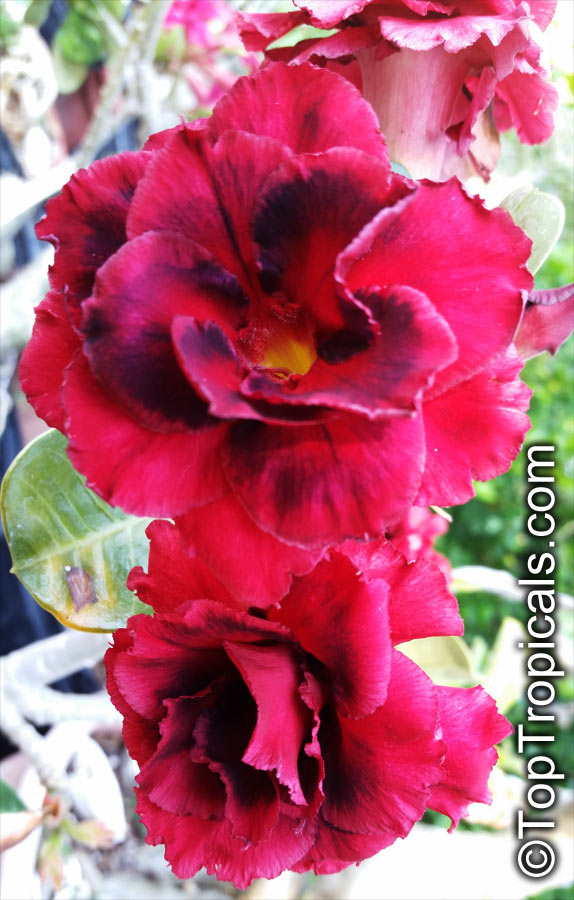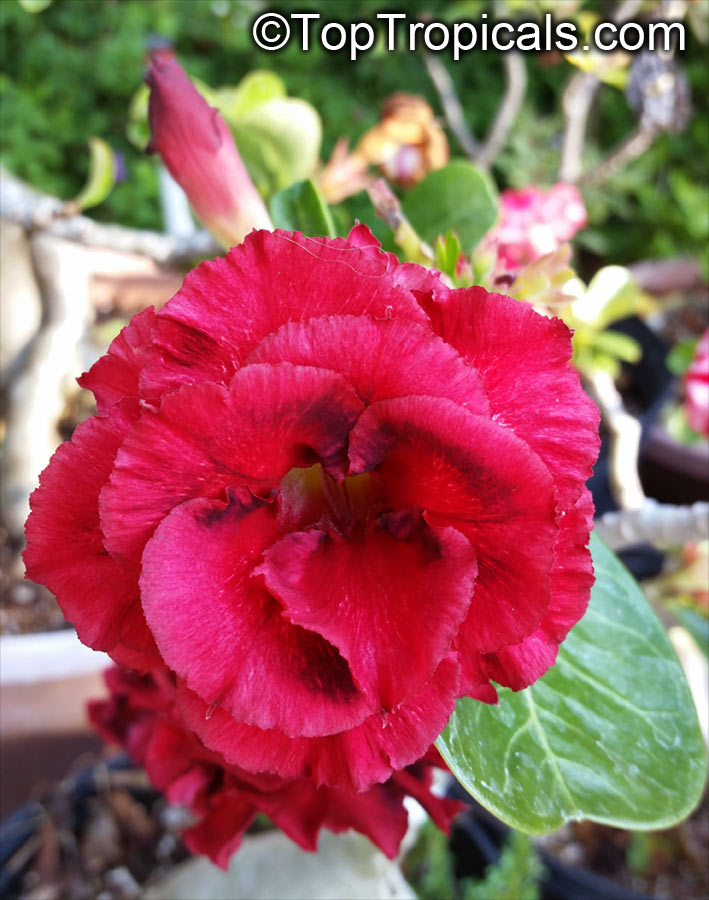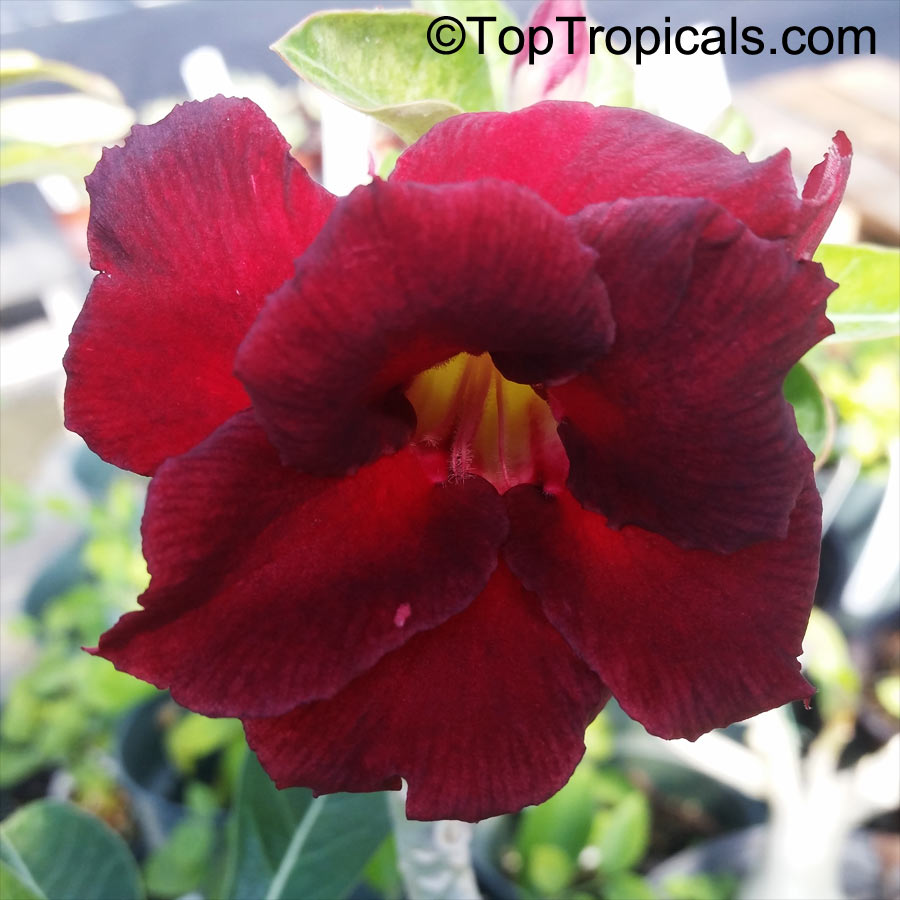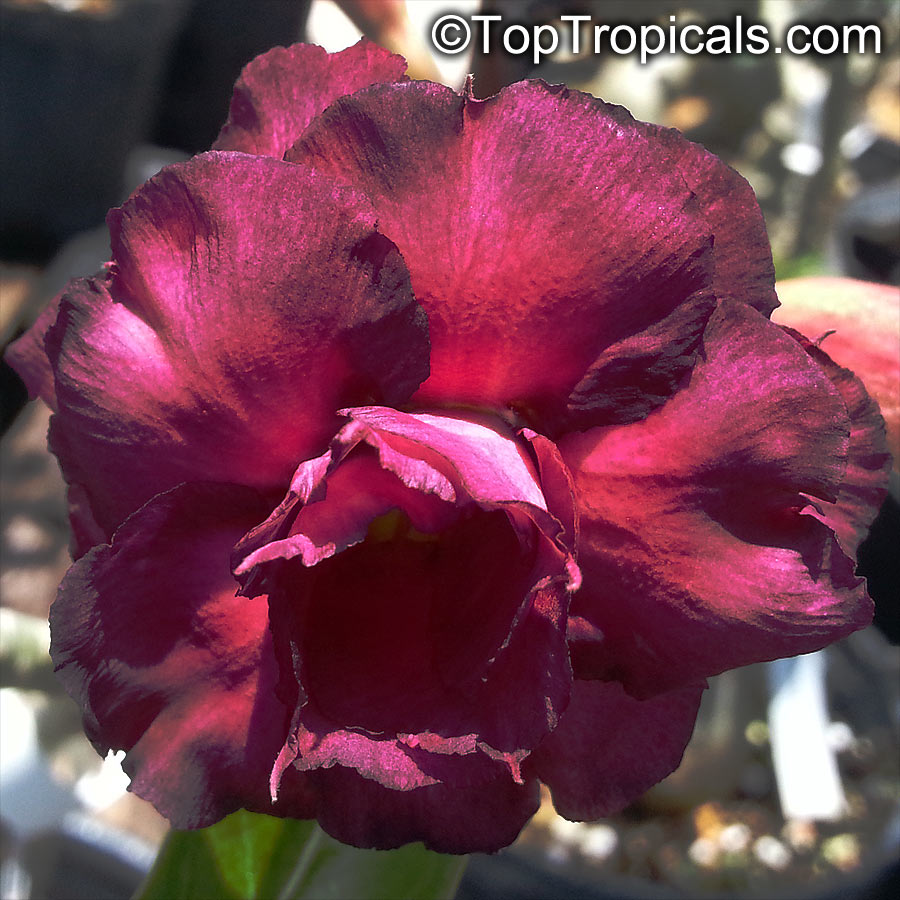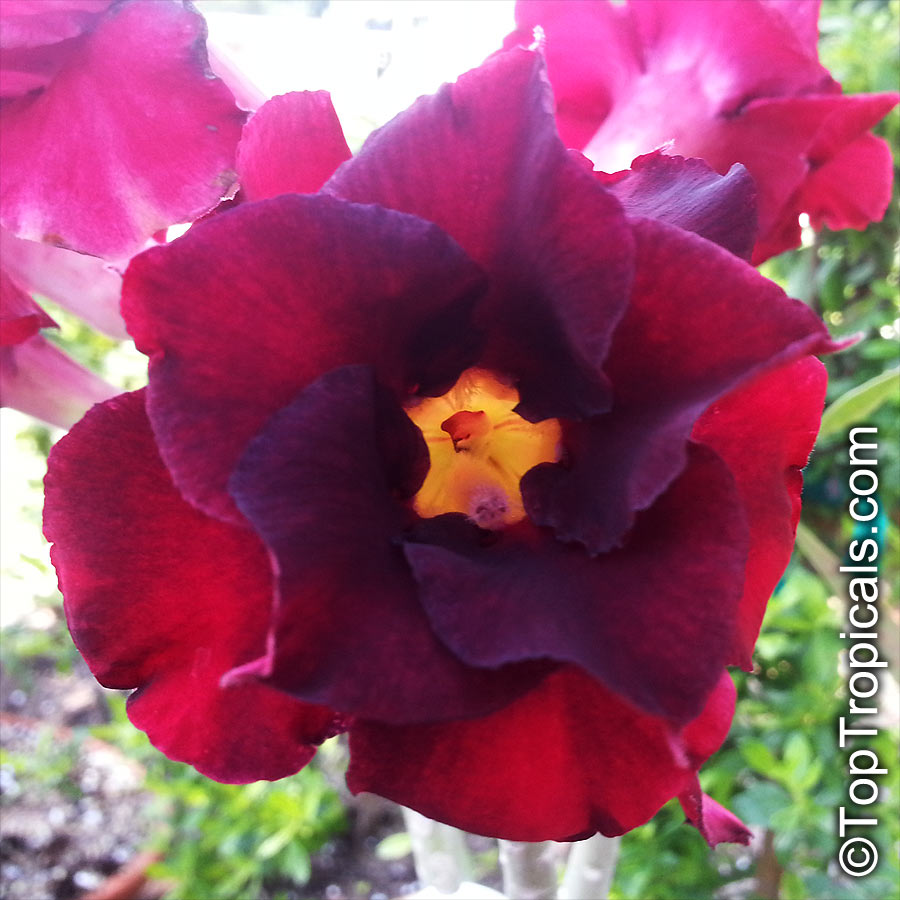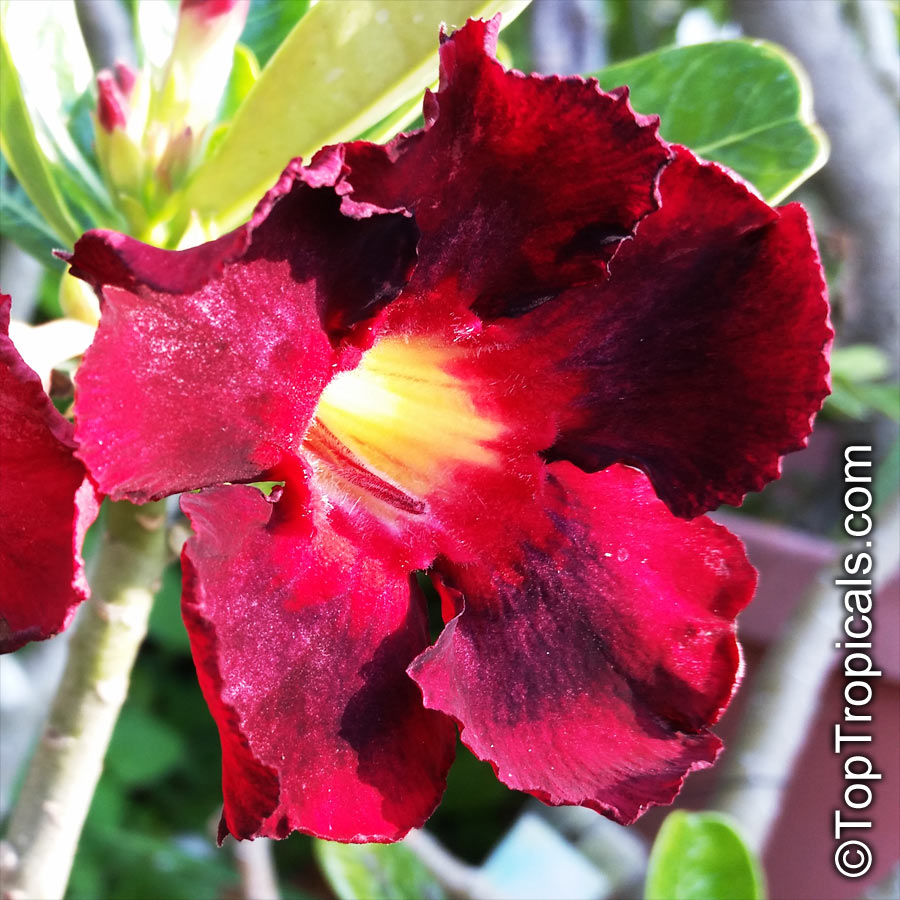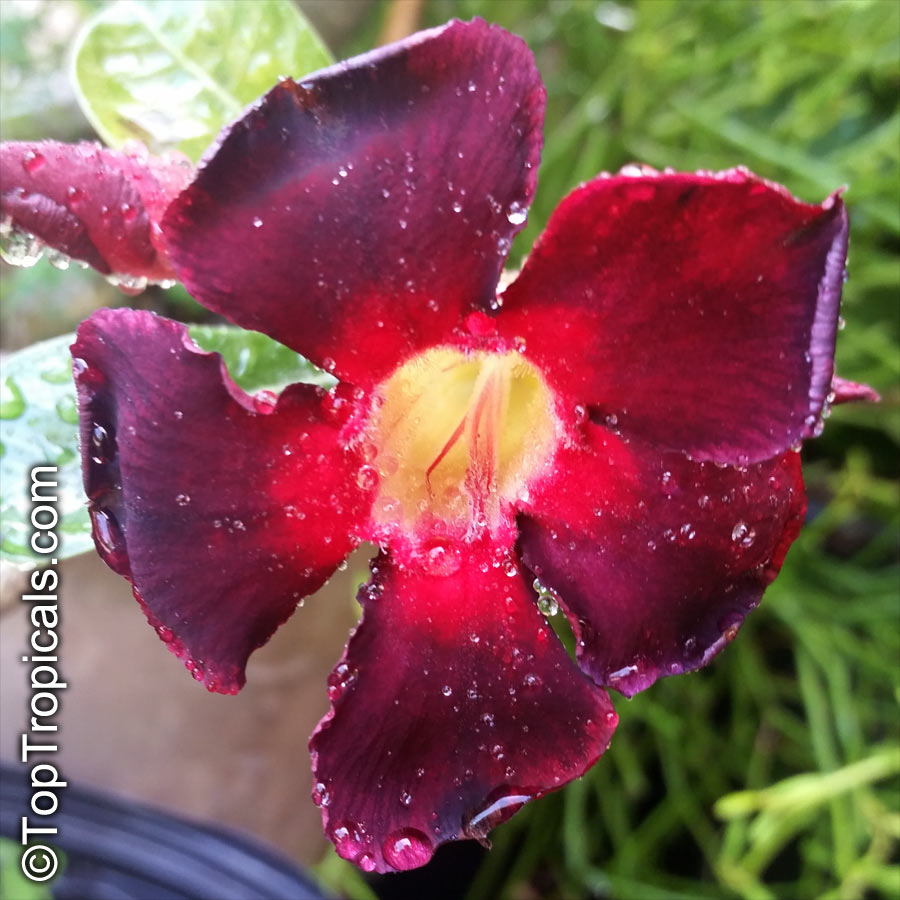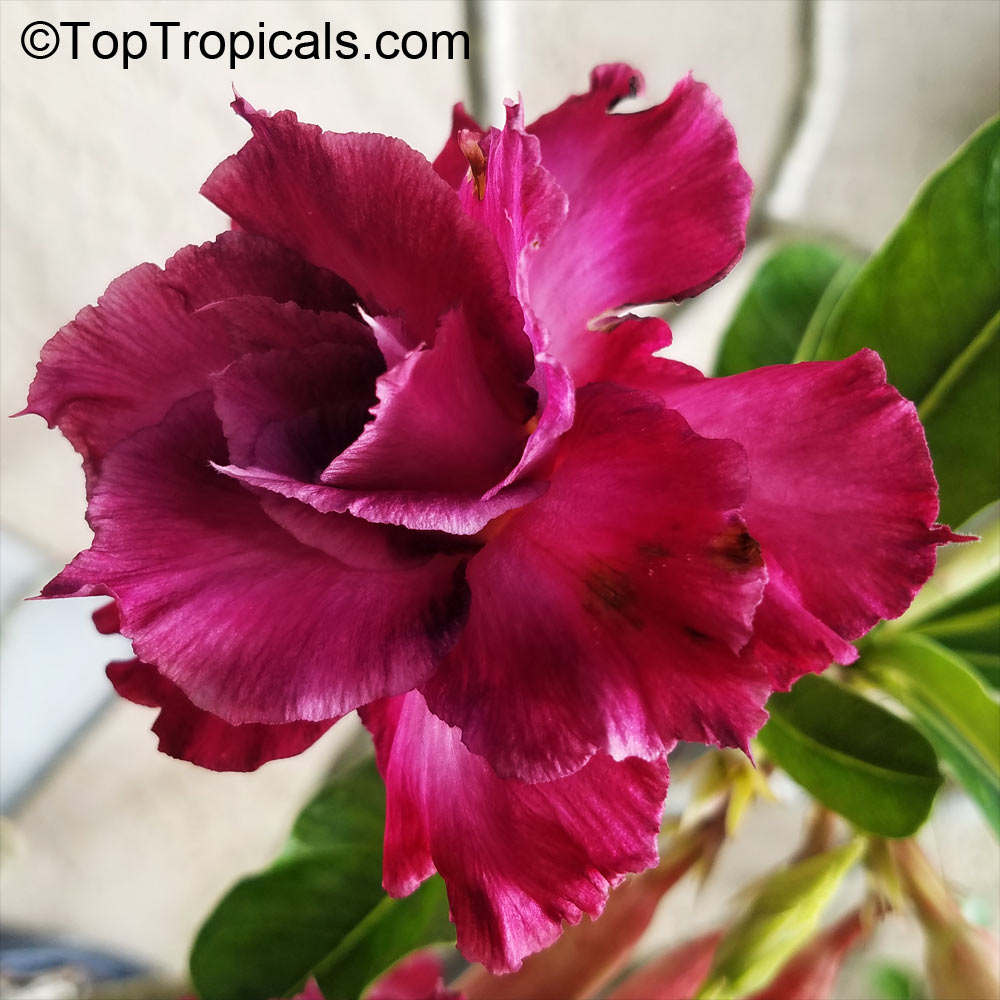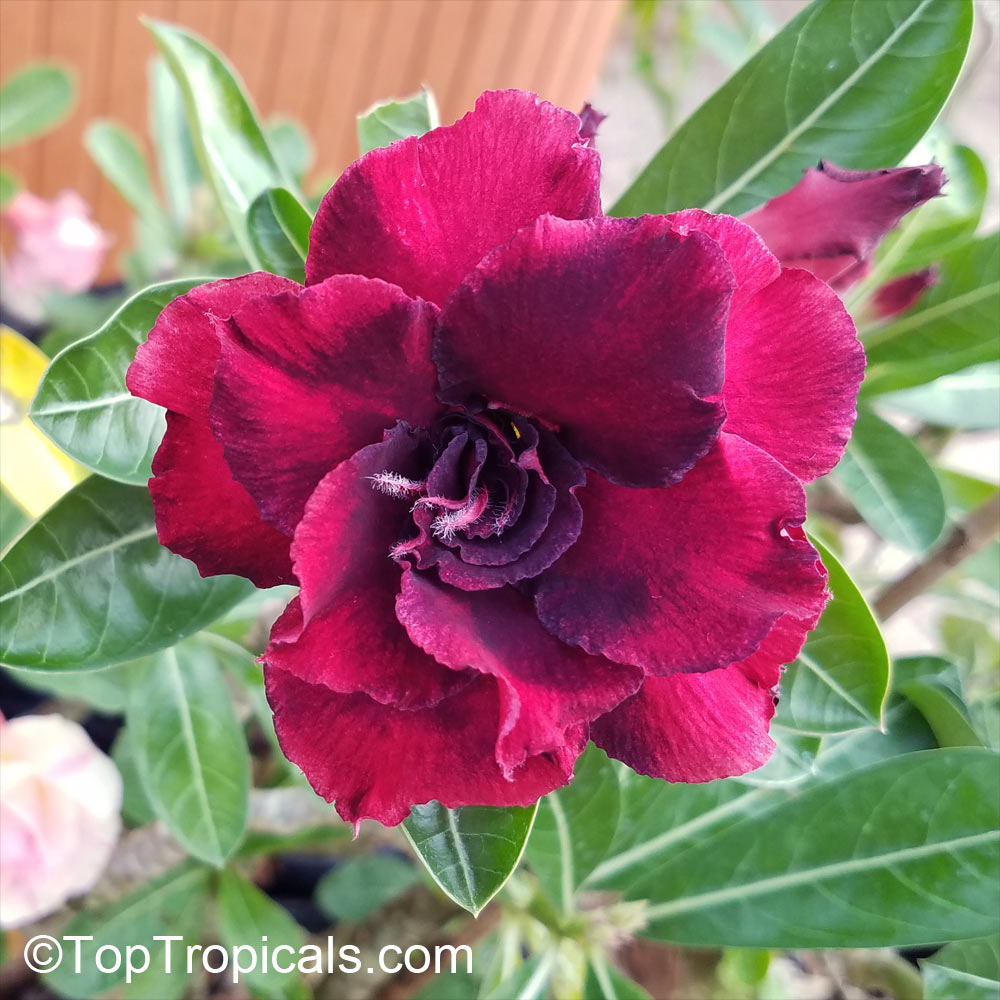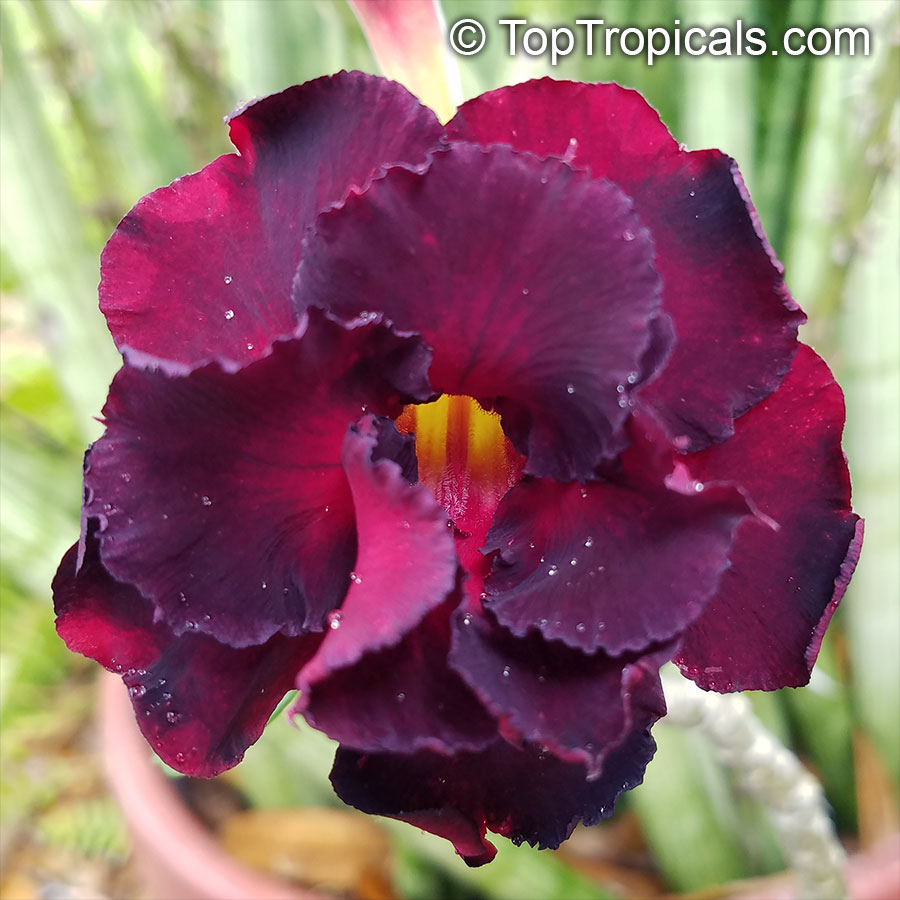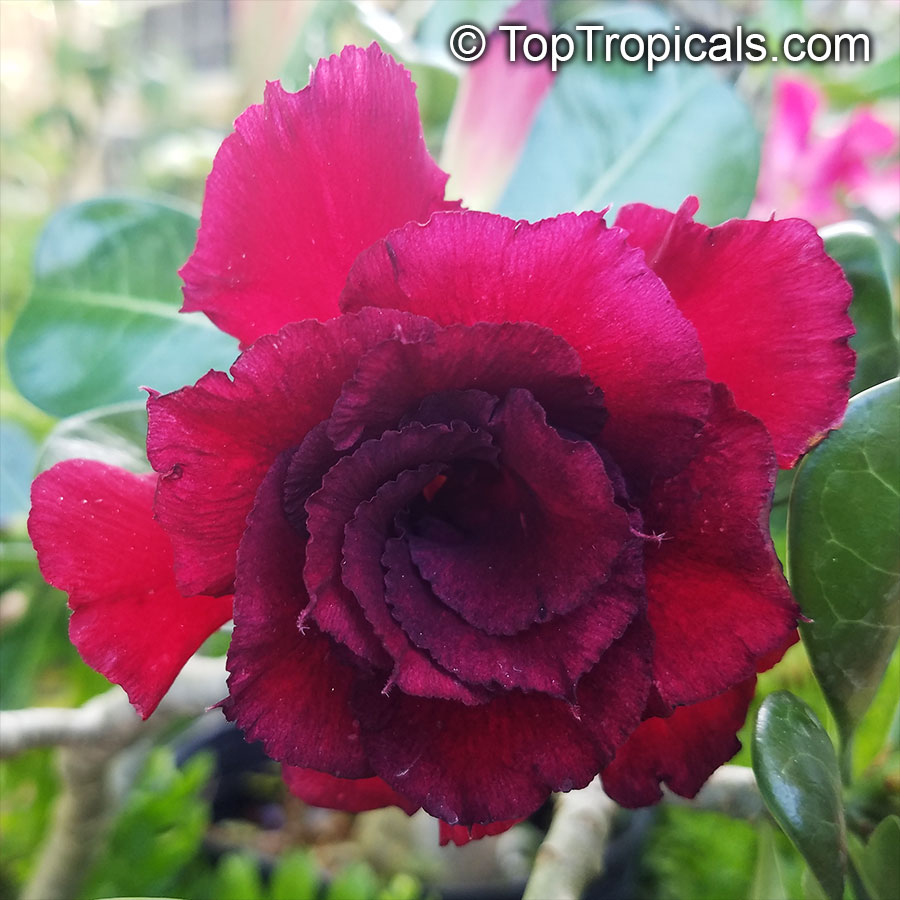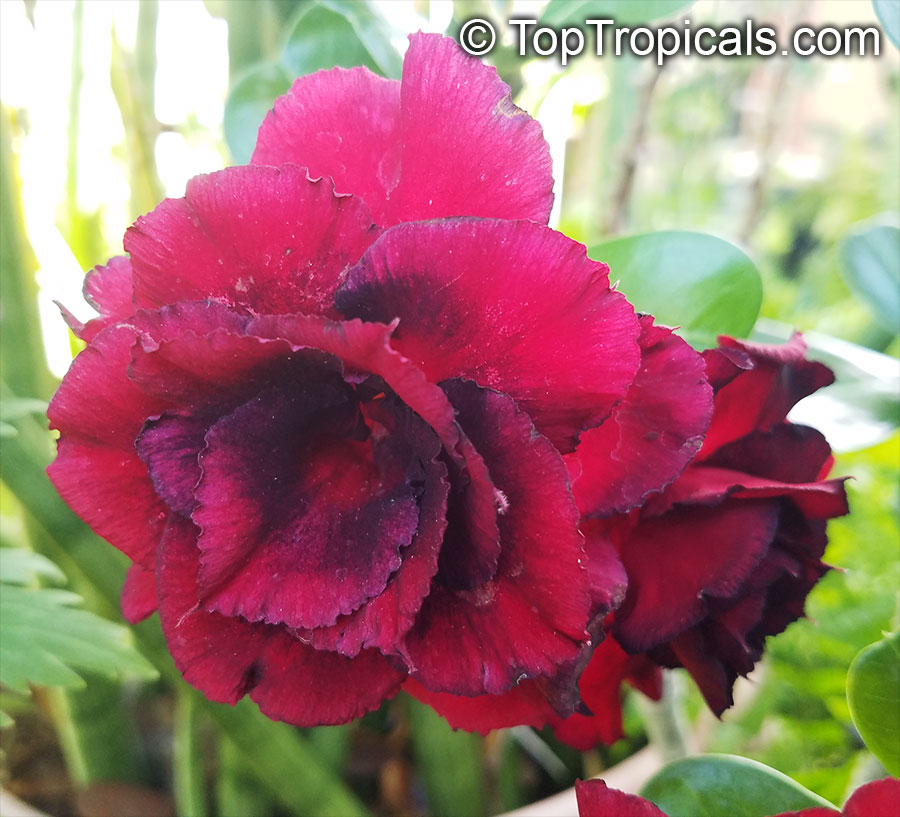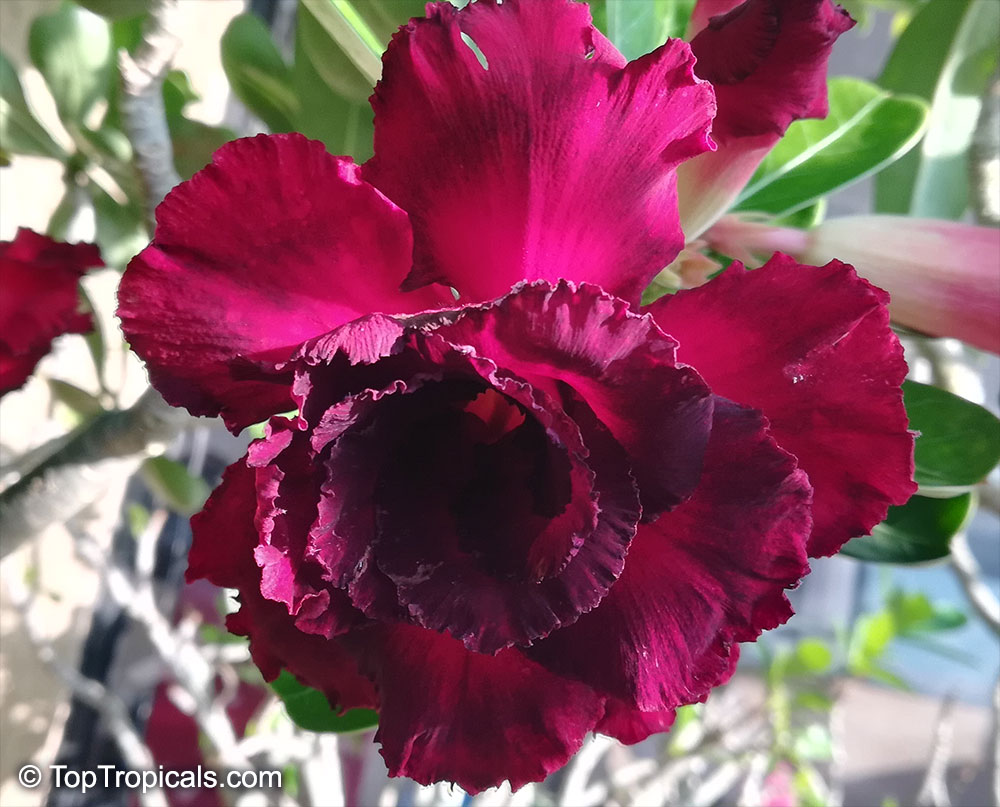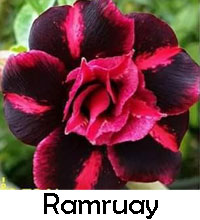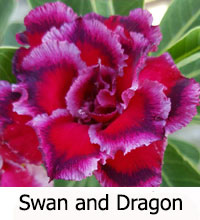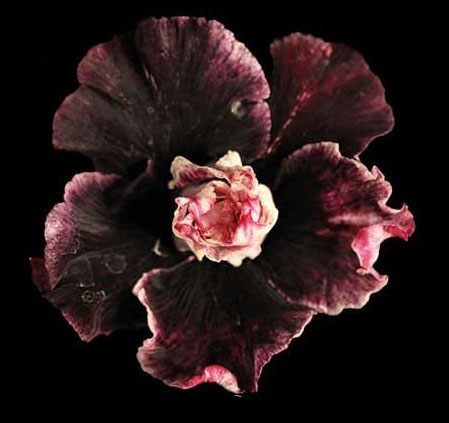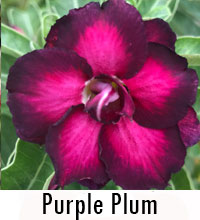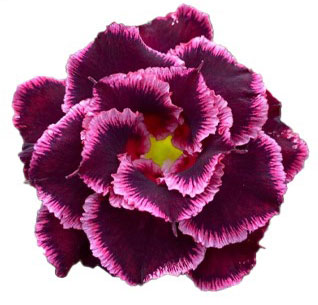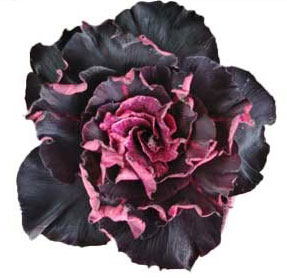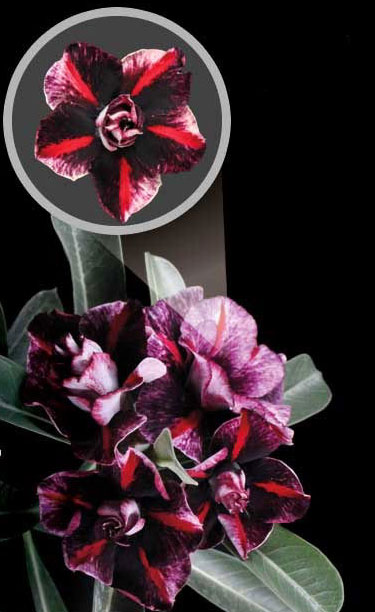Adenium sp. 'Dark-colored Flower' (Black Desert Rose)
Top Tropicals Plant Encyclopedia
Botanical name: Adenium sp.
Common name: Black Desert Rose
Cultivar: Dark-colored Flower
Family: Apocynaceae
Origin: Arabia and East Africa









These bizarre hybrids appeared on the market a few years ago. At first, pictures looked confusing and unreal. When our first Black adeniums went into bloom, we were disappointed with red buds popped up on the plants... However after the dark red flowers opened, they started to darken as they aged, and some varieties turned so dark in color that it was close to black or brown. Some varieties have only black contour around red flower. So, black flower is actually a very old flower! So be, patient and let it age as an old good vine. See picture of darkening process.
Adeniums have many spectacular hybrids. The basic culture is very similar to orchids. A small pot with excellent drainage is a must. Adeniums do not like both over-watering or drying-out. There is a little secret of how to create a weird shape of the base: lift the plant a bit every time you re-pot the plant, so that the upper part of roots will be a little exposed. The plant will form more roots that will go down. To make your plant develop a large swollen base/trunk, you'll need a good quality fertilizer. Fertilizer requirement for swelling up trunks is also used to increase flowering. It shouldn't be too high in nitrogen, the middle number should be the highest. Never apply fertilizer directly on roots and do not liquid feed when a plant is thirsty: always water first slightly to avoid root burn and leaf drop. Do not wet leaves. Adeniums need lots of light for heavy flowering. Most hybrids and species start blooming in the spring when the conditions are warm and days get longer, and continue blooming through the fall and winter in warmer climates. Adeniums like a neutral to hard water. Acidic water tends to sour the soil too fast and may cause root rot. Water plants preferably in the early morning, and allow them to drink up throughout the day. Watering can be done daily to every few days. Never allow your plants to sit in a saucer of water, but don't let them to dry out too often - this causes adeniums to go into early dormancy.
Cultivars: Adenium sp. 'Dark-colored Flower' (Black Desert Rose)
- Adenium sp. ''Black Amaryllis'' ('Black Amaryllis' Desert Rose)
- Adenium sp. ''Black Asia'' ('Black Asia' Desert Rose)
- Adenium sp. ''Black Border'' ('Black Border' Desert Rose)
- Adenium sp. ''Black Boy'' ('Black Boy' Desert Rose)
- Adenium sp. ''Black Magic'' ('Black Magic' Desert Rose)
- Adenium sp. ''Black Purple'' ('Black Purple' Desert Rose)
- Adenium sp. ''Black Rahu'' ('Black Rahu' Desert Rose)
- Adenium sp. ''Black Sheep'' ('Black Sheep' Desert Rose)
- Adenium sp. ''Black Swan'' ('Black Swan' Desert Rose)
- Adenium sp. ''Chok Dee'' ('Chok Dee' Desert Rose)
- Adenium sp. ''Dang Hassadee'' ('Dang Hassadee' Desert Rose)
- Adenium sp. ''Good Night'' ('Good Night' Desert Rose)
- Adenium sp. ''Immortality'' ('Immortality' Desert Rose)
- Adenium sp. ''King Of Purple'' ('King of Purple' Desert Rose)
- Adenium sp. ''Lovely Black'' ('Lovely Black' Desertr Rose)
- Adenium sp. ''Miss Ninja'' ('Miss Ninja' Desert Rose)
- Adenium sp. ''Moung Kusuma'' ('Moung Kusuma' Desert Rose)
- Adenium sp. ''Moung Mongkol'' ('Moung Mongkol' Desert Rose)
- Adenium sp. ''Purple Ruby'' ('Purple Ruby' Desert Rose)
- Adenium sp. ''Ram Ruay''
Similar plants: Adenium sp. 'Dark-colored Flower' (Black Desert Rose)
- Adenium arabicum (Desert Rose)
- Adenium boehmianum (Desert Rose)
- Adenium multiflorum (Desert Rose)
- Adenium obesum (Desert Rose)
- Adenium somalense (Desert Rose)
- Adenium sp. 'Yellow Flower' (Yellow Desert Rose)
- Adenium sp. (Adenium)
- Adenium sp. 'Variegatum' (Variegated Desert Rose)
- Adenium sp. 'Single Flower' (Desert Rose)
- Adenium sp. 'Double Flower' (Double Flower Desert Rose Hybrid)
- Adenium swazicum (Desert Rose)
Recommended Supplies: SUNSHINE Megaflor - Bloom Nutrition Booster
SUNSHINE-Epi - Caudex booster
Adenium Soilless Mix
Succulent Care. This plant is shipped bare-rooted. Plant it in well-drained soil mix, water and keep in warm (75-80F) place in filtered light. Let soil dry between waterings.
Recommended Supplies: SUNSHINE Megaflor - Bloom Nutrition Booster
SUNSHINE-Epi - Caudex booster
Adenium Soilless Mix
Succulent Care. This plant is shipped bare-rooted. Plant it in well-drained soil mix, water and keep in warm (75-80F) place in filtered light. Let soil dry between waterings.
Recommended Supplies: SUNSHINE Megaflor - Bloom Nutrition Booster
SUNSHINE-Epi - Caudex booster
Adenium Soilless Mix
Succulent Care. This plant is shipped bare-rooted. Plant it in well-drained soil mix, water and keep in warm (75-80F) place in filtered light. Let soil dry between waterings.
Recommended Supplies: SUNSHINE Megaflor - Bloom Nutrition Booster
SUNSHINE-Epi - Caudex booster
Adenium Soilless Mix
Succulent Care. This plant is shipped bare-rooted. Plant it in well-drained soil mix, water and keep in warm (75-80F) place in filtered light. Let soil dry between waterings.
Recommended Supplies: SUNSHINE Megaflor - Bloom Nutrition Booster
SUNSHINE-Epi - Caudex booster
Adenium Soilless Mix
Succulent Care. This plant is shipped bare-rooted. Plant it in well-drained soil mix, water and keep in warm (75-80F) place in filtered light. Let soil dry between waterings.
Recommended Supplies: SUNSHINE Megaflor - Bloom Nutrition Booster
SUNSHINE-Epi - Caudex booster
Adenium Soilless Mix
Succulent Care. This plant is shipped bare-rooted. Plant it in well-drained soil mix, water and keep in warm (75-80F) place in filtered light. Let soil dry between waterings.
Recommended Supplies: SUNSHINE Megaflor - Bloom Nutrition Booster
SUNSHINE-Epi - Caudex booster
Adenium Soilless Mix
Succulent Care. This plant is shipped bare-rooted. Plant it in well-drained soil mix, water and keep in warm (75-80F) place in filtered light. Let soil dry between waterings.
Recommended Supplies: SUNSHINE Megaflor - Bloom Nutrition Booster
SUNSHINE-Epi - Caudex booster
Adenium Soilless Mix
Succulent Care. This plant is shipped bare-rooted. Plant it in well-drained soil mix, water and keep in warm (75-80F) place in filtered light. Let soil dry between waterings.
Recommended Supplies: SUNSHINE Megaflor - Bloom Nutrition Booster
SUNSHINE-Epi - Caudex booster
Adenium Soilless Mix
Succulent Care. This plant is shipped bare-rooted. Plant it in well-drained soil mix, water and keep in warm (75-80F) place in filtered light. Let soil dry between waterings.
Recommended Supplies: SUNSHINE Megaflor - Bloom Nutrition Booster
SUNSHINE-Epi - Caudex booster
Adenium Soilless Mix
Succulent Care. This plant is shipped bare-rooted. Plant it in well-drained soil mix, water and keep in warm (75-80F) place in filtered light. Let soil dry between waterings.
Recommended Supplies: SUNSHINE Megaflor - Bloom Nutrition Booster
SUNSHINE-Epi - Caudex booster
Adenium Soilless Mix
Succulent Care. This plant is shipped bare-rooted. Plant it in well-drained soil mix, water and keep in warm (75-80F) place in filtered light. Let soil dry between waterings.
